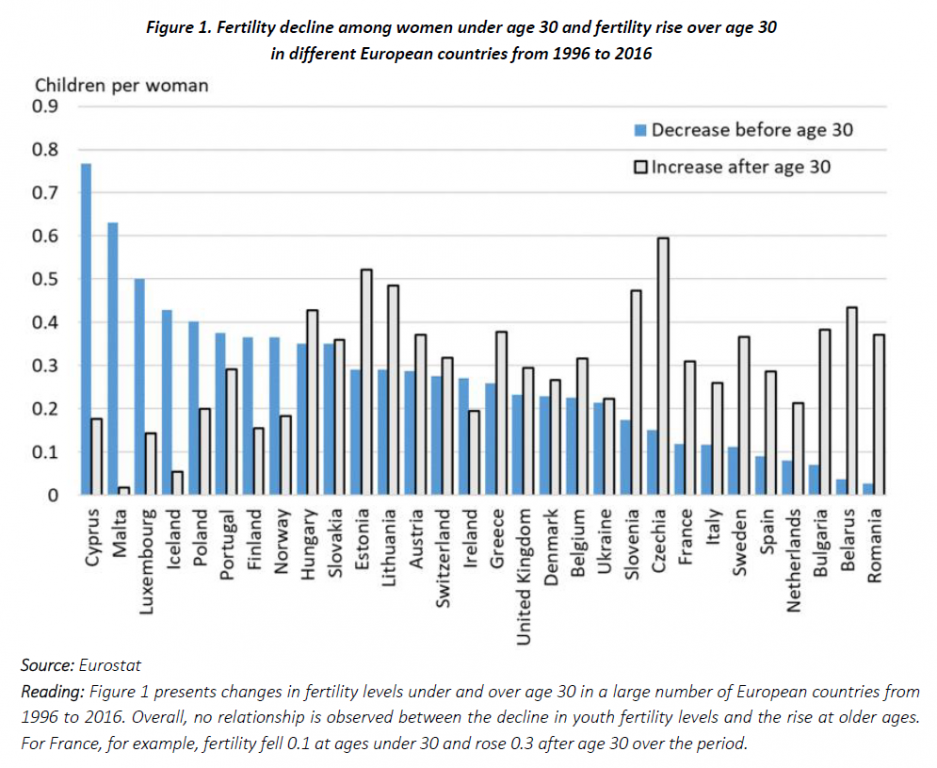Late maternity does not bring about lower fertility in European countries
Press release Published on 18 November 2021
Late maternity does not bring about lower fertility in European countries
The longer first births are postponed, the more likely they are not to occur and the fewer children the woman in question is likely to have. The reasons for this are social, normative, and, of course, biological. But how does the relationship between a woman’s age at the birth of her first child and her fertility level play out at the scale of countries? Eva Beaujouan, a researcher at Austria’s Wittgenstein Centre, and INED researcher Laurent Toulemon have worked to answer this question. Studying women’s fertility and their mean age at childbirth over the last forty years in countries across Europe, they show that the fact that women have their first child at later ages does not account for lower fertility at the country level. Policies for facilitating reconciliation of family and work lives play a much more important role in a country’s fertility.
In France as in most European countries, women now have their first child later in life
Having one’s first child at a later age is a general development that is due first and foremost to fertility decline among young women, due in turn to the spread of effective contraceptive methods. The fall in fertility is also associated with delay in some of the behaviors that constitute the transition to adulthood; e.g., leaving the parental home, a general rise in educational attainment, acquiring one’s first stable job. In France, women’s mean age at maternity rose from 26.5 in 1977 to 30.6 in 2016. A similar trend is observed in all European countries, although changes in respective fertility levels—measured by the total fertility rate (TFR)—appear to vary greatly (Figure 1).
Later age at first birth does not always imply a “catch up” effect at older ages
Data is available for many countries for the 1996-2016 period (Figure 1). Overall, fertility before age 30 fell during the period while fertility after age 30 rose. But generally speaking, the countries where the post-30 rise is greater are not those where the pre-30 fall is strong (and therefore not those that would call for the biggest catch-up) but rather those where the pre-30 fall is moderate (Figure 1). So while reasoning in “delay and catch-up” terms makes sense at the individual level it cannot describe the variability of fertility trends in the different European countries; in sum, the decline at young ages and the rise at older ones appear to be simultaneous phenomena that are not directly related.
Women’s increased occupational activity a major driver of fertility trends
In countries where it is particularly hard to reconcile family and work lives we find both fewer working women and fewer children, as women there have to choose between working and raising young children. In countries where it is easier to balance work and family, mothers more often have a job and working women have more children. At the country level, then, context effects dominate individual constraints, notably biological ones. A greater part of the fertility trends of various European countries are explained by policies that make it possible to have children relatively late, such as measures facilitating work-family life balance, than to youth fertility decline or biological reproductive constraints. This is why family policy and immediate economic conditions play such an important role in fertility levels.

|
DATA USED The study used aggregate data on fertility in European countries from Eurostat and the Human Fertility Database, diffused by the Max Planck Institute for Demographic Research and the Vienna Institute of Demography. When necessary, data directly from national institutes was used. In addition to the standard fertility indicators used to contextualize the study (TFR, mean age at childbirth), fertility rates by age were used to detail the effects of childbirth delay on fertility over the last decades. Changes in fertility spacing were compared with changes in fertility levels, with emphasis on total number of births and the proportion of women who remain childless in each generation. |
For more information, see:
Eva Beaujouan et Laurent Toulemon, 2021, European countries with delayed childbearing are not those with lower fertility, Genus 77: 1-15.
Published in a scientific journal referenced by French national evaluation authorities.








